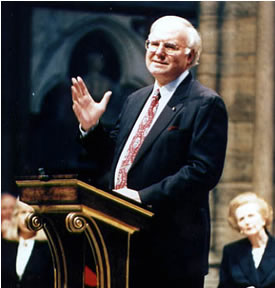 Please consider this a short follow-up post after my recent "Watching Katrina with Sen. Moynihan" effort. You may recall that this raised some questions about the moral, cultural and even religious issues looming in the background of the failed evacuation of New Orleans.
A key question: To what degree is this tragedy rooted in questions linked to family life and, in particular, the lack of fathers in most impoverished homes? I suggested that, at some point, these questions would begin to influence discussions of the future of New Orleans, or at least the city core in Orleans Parish.
Please consider this a short follow-up post after my recent "Watching Katrina with Sen. Moynihan" effort. You may recall that this raised some questions about the moral, cultural and even religious issues looming in the background of the failed evacuation of New Orleans.
A key question: To what degree is this tragedy rooted in questions linked to family life and, in particular, the lack of fathers in most impoverished homes? I suggested that, at some point, these questions would begin to influence discussions of the future of New Orleans, or at least the city core in Orleans Parish.
Soon thereafter, David Brooks wrote about this issue in The New York Times:
In those cultural zones, many people dropped out of high school, so it seemed normal to drop out of high school. Many teenage girls had babies, so it seemed normal to become a teenage mother. It was hard for men to get stable jobs, so it was not abnormal for them to commit crimes and hop from one relationship to another. Many people lacked marketable social skills, so it was hard for young people to learn these skills from parents, neighbors and peers.
If we just put up new buildings and allow the same people to move back into their old neighborhoods, then urban New Orleans will become just as rundown and dysfunctional as before.
Meanwhile, the conservative Catholic scholar Michael Novak -- winner of the 1994 Templeton Prize for progress in religion -- wrote an essay at National Review Online that dug into the 2000 census data for New Orleans.
It is sobering reading, but I urge those who are interested in the future of the Crescent City to take the plunge. Sadly, Novak (pictured) concludes that New Orleans is the "prototypical, old-time welfare-state city." Who would be left stranded? Sadly, that was easy to predict:
In 2000, there were only 25,000 two-parent families in New Orleans with children under 18. By contrast, there were more than 26,000 female householders with children under 18, and no husband present. In other words, slightly more mothers all alone with children than married-couple mothers. In addition, there were more than 18,000 householders who were more than 65 years old and living alone. Of these, most would normally be female.
If you add together the 26,000 female householders with children under 18, no husband present, and the 18,000 householders more than 65 years old and living alone, that is an estimated 40,000 female-headed households. That explains the pictures we are seeing on television, which are overwhelming female, most often with young children. The chances of persons in this demographic being employed full-time, year round, and with a good income, are not high. The chances of them living in poverty, and without an automobile, are exceedingly high.
So what happened? We are only now beginning to see national-level media dig into this topic. This process will be painful, but there is no way around it.
Here is the opening of a blunt story in today's Los Angeles Times, written by Nicholas Riccardi and James Rainey. The headline is like a brick up against the side of the head: "Save Yourself -- New Orleans had a plan to warn the poor, but it sat on a shelf in L.A."
NEW ORLEANS -- After years of warnings, community leaders this summer prepared a video guide to hurricane evacuations with a stark message: Many of this city's poor, including 134,000 without cars, could be left behind in a killer storm.
But the 30-minute DVD still has not arrived. Some 70,000 of the newly minted videos that were to be released this month remain on warehouse shelves in Los Angeles. Their warning: Save yourself, and help your neighbors if you can.
"Don't wait for the city, don't wait for the state, don't wait for the Red Cross," the Rev. Marshall Truehill warns in the public service announcement.
In the end, the family is the final safety net.
